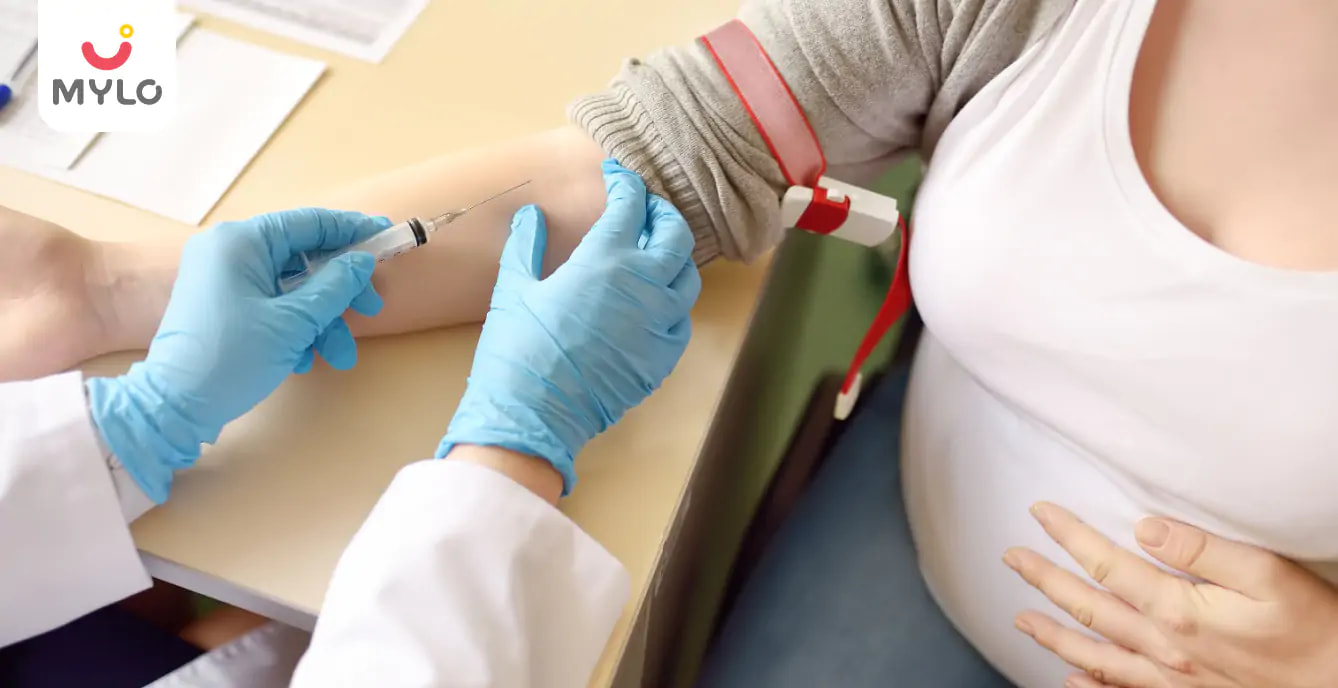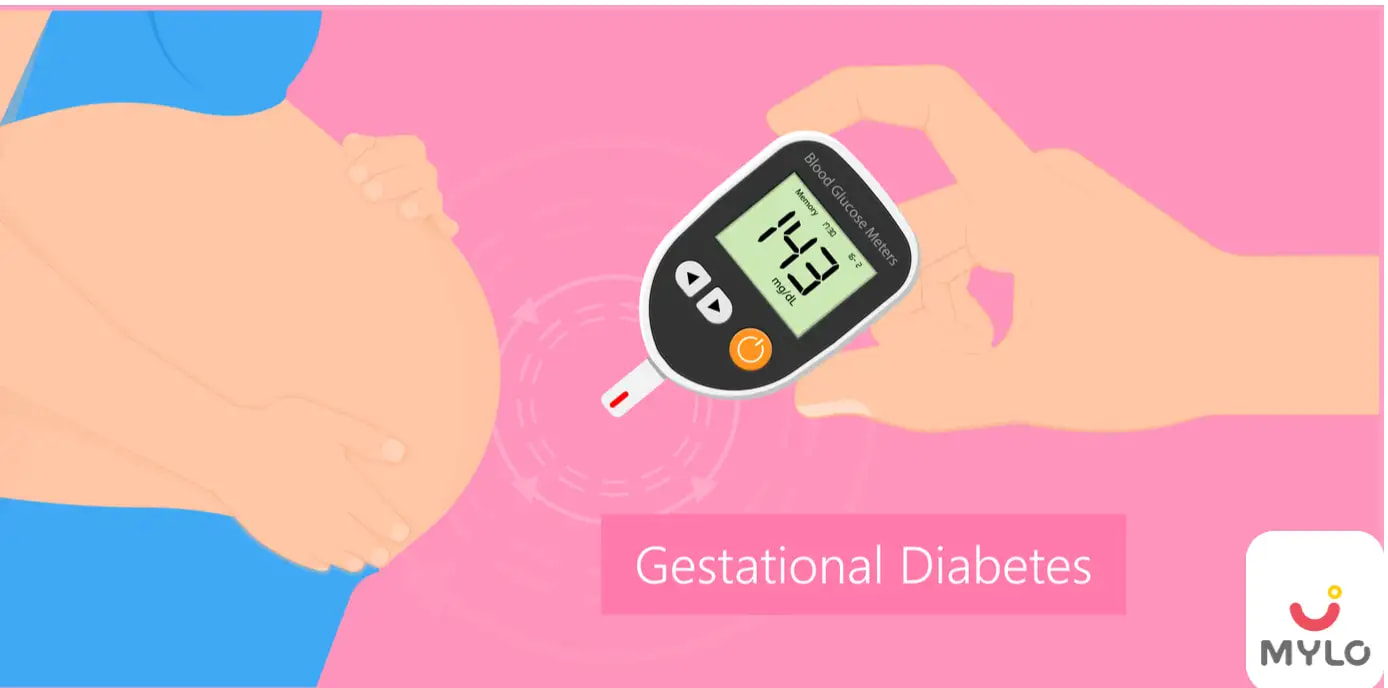Home

Diabetes during Pregnancy

Gestational Diabetes Mellitus in Pregnancy
In this Article

Diabetes during Pregnancy
Gestational Diabetes Mellitus in Pregnancy
Updated on 3 November 2023
Gestational diabetes mellitus definition says that it is a condition in which the placenta produces a hormone that prevents the usage of insulin effectively. This condition is also referred to as insulin resistance. Due to this, glucose accumulates in the blood rather than being absorbed by the cells. However, Gestational diabetic symptoms disappear post-delivery.
Gestational Diabetes During Pregnancy
The first occurrence of gestational diabetes is found at the time of pregnancy. Gestational diabetes is a condition in which blood sugar levels are high during pregnancy. Though Gestational diabetes goes away after the birth of the baby, it usually has an impact on the baby's health. Approximately 3 to 8 percent of all pregnant women are diagnosed with gestational diabetes.
Symptoms of Gestational Diabetes Mellitus
Women with gestational diabetes usually have no symptoms or find out during the pregnancy after a routine check-up. Some symptoms include:
1. Fatigue
Experiencing extreme fatigue and feeling constantly tired, even after getting enough sleep and proper food.
2. Blurred vision
High blood glucose attracts fluid from tissues, including the eyes' lenses. This affects the vision.
3. Extreme thirst
When kidneys cannot function properly, the excess glucose is excreted into the urine along with the fluid in the body and the tissues, resulting in extreme thirst and dehydration.
4. Nausea
Due to high blood sugar levels being elevated for a longer period of time. Eating can make people with GD nauseous, even though they are hungry.
5. Frequent bladder, vaginal, or skin infections
High levels of blood glucose can lead to poor blood flow and impair the body's natural healing process. In women with GD, bladder and vaginal yeast infections may occur more often and not heal as fast.
6. Frequent urination
The kidneys remove excess sugar in the bloodstream, and the remaining sugar which is unable to be absorbed by the kidneys is urinated out along with fluid from the tissues. The body then starts feeling dehydrated and thirsty, which leads to more water consumption and, in effect, frequent urination.
7. Sugar in the urine
During pregnancy, the body requires a lot of energy as the baby grows, but sometimes the production of insulin is not sufficient to keep up with demand. Due to a lack of insulin, levels of sugar are high, and it will show up in the urine.
What are the Causes of Gestational Diabetes Mellitus?
Gestational diabetes during pregnancy occurs when enough insulin is not produced by the pancreas of the pregnant woman, and even if it is produced, the body is not able to utilize it properly. Without enough insulin, glucose builds up in the blood it's called hyperglycemia. There is an increased demand for insulin at the beginning of pregnancy, causing gestational pregnancy.
Gestational Diabetes Risk Factors
Risk factors include:
-
Overweight or obese
-
Physically inactive
-
Polycystic ovary syndrome
-
History of diabetes
-
Having prediabetes
-
Gestational diabetes during a previous pregnancy
How is Gestational Diabetes Mellitus Diagnosed?
The healthcare provider will perform a blood test. The test includes:
-
Glucose screening test: The healthcare provider will ask you to take a sweet drink. After an hour, a blood sample is taken to check blood sugar levels. If there is an increase in blood sugar, there will be another test, known as the glucose tolerance test.
-
Glucose tolerance test: This test measures glucose levels in the body after a fast of nine hours. Then the second blood sample is drawn after taking the sweet drink and checked for glucose every hour for three hours. If the glucose readings are higher than expected, the diagnosis confirms diabetes.
Complications of Gestational Diabetes Mellitus
Gestational diabetes that is not managed carefully can result in high blood sugar levels. High blood sugar can cause problems for the mother and the baby, with a high chance of needing surgery to deliver (C-section).
May affect your baby:
-
Being very large (9 pounds or more), making delivery quite difficult
-
Being born early can cause respiratory distress syndrome
-
Having low blood sugar
-
Develop type 2 diabetes later in life
May affect you:
-
Many women with gestational diabetes continue to develop type 2 diabetes in the future
-
Have risk of high blood pressure, as well as preeclampsia
-
Most likely to have a C-section delivery
You may like: Symptoms Diagnosis Treatment Complications of Gestational Diabetes Mellitus During Pregnancy
What is the Treatment for Gestational Diabetes Mellitus?
Gestational diabetes treatment options include:
1. Lifestyle changes
Follow a healthy eating plan planned by your doctor or dietitian. Also, exercise regularly to maintain a healthy weight.
2. Blood Sugar Monitoring
Screening of blood sugar is important to ensure blood sugar levels stay in a healthy range.
3. Medication
If diet and exercise are not helping to manage blood sugar levels, there is a need for insulin injections to lower your blood sugar. There are also some prescribed medications that can help.
Summary
Gestational diabetes is a consequential condition seen in pregnant women with higher blood sugar. It is mostly diagnosed during the second trimester, around 24 to 28 weeks of pregnancy. Both mother and baby will have health-related complications if not treated for diabetes in time. With proper diet and exercise, GDM in pregnancy can be managed well. If diet and exercise cannot control the conditions, then medication is needed. Women with GD also have a higher possibility of having type 2 diabetes in the future.
It is advised to talk to a doctor about how to manage and keep a check on blood sugar to reduce the risk of diabetes.
You may also like to watch:
References
- Catherine Godin et al.; (2012). CBHSSJB Protocol for the Management of Gestational Diabetes Mellitus (GDM) and Pre-existing diabetes during pregnancy. www.creehealth.org
- D. Alexander; Managing Gestational Diabetes. www.nichd.nih.gov



Written by
Mittali Khurana
Mittali is a content writer by profession. She is a dynamic writer with 04+ years of experience in content writing for E-commerce, Parenting App & Websites, SEO.
Read MoreGet baby's diet chart, and growth tips

Related Articles
RECENTLY PUBLISHED ARTICLES
our most recent articles

Diet & Nutrition
গর্ভাবস্থায় আলুবোখরা: উপকারিতা ও ঝুঁকি | Prunes During Pregnancy: Benefits & Risks in Bengali

Diet & Nutrition
গর্ভাবস্থায় হিং | ঝুঁকি, সুবিধা এবং অন্যান্য চিকিৎসা | Hing During Pregnancy | Risks, Benefits & Other Treatments in Bengali

Women Specific Issues
স্তনের উপর সাদা দাগ: লক্ষণ, কারণ এবং চিকিৎসা | White Spots on Nipple: Causes, Symptoms, and Treatments in Bengali

Diet & Nutrition
গর্ভাবস্থায় পোহা: উপকারিতা, ধরণ এবং রেসিপি | Poha During Pregnancy: Benefits, Types & Recipes in Bengali

Diet & Nutrition
গর্ভাবস্থায় মাছ: উপকারিতা এবং ঝুঁকি | Fish In Pregnancy: Benefits and Risks in Bengali

Diet & Nutrition
গর্ভাবস্থায় রেড ওয়াইন: পার্শ্ব প্রতিক্রিয়া এবং নির্দেশিকা | Red Wine During Pregnancy: Side Effects & Guidelines in Bengali
- ইনার থাই চ্যাফিং: কারণ, উপসর্গ এবং চিকিৎসা | Inner Thigh Chafing: Causes, Symptoms & Treatment in Bengali
- গর্ভাবস্থায় ব্রাউন রাইস: উপকারিতা ও সতর্কতা | Brown Rice During Pregnancy: Benefits & Precautions in Bengali
- Velamentous Cord Insertion - Precautions, Results & Safety
- Unlock the Secret to Flawless Skin: 7 Must-Have Qualities in a Face Serum
- Unlock the Secret to Radiant Skin: How Vitamin C Serum Can Transform Your Complexion
- Gender No Bar: 10 Reasons Why Everyone Needs a Body Lotion
- Unlock the Secret to Radiant Skin How to Choose the Perfect Body Lotion for Your Skin Type
- Top 10 Reasons to Apply a Body Lotion After Every Bath
- Communication in Toddlers: Milestones & Activities
- How to Improve Vocabulary for Toddlers?
- A Comprehensive Guide to Understanding Placenta Accreta
- Vulvovaginitis in Toddlers Causes, Symptoms and Treatment
- A Comprehensive Guide to Understanding Cerebral Palsy in Children
- Bitter Taste in Mouth During Pregnancy: Understanding the Causes and Remedies


AWARDS AND RECOGNITION

Mylo wins Forbes D2C Disruptor award

Mylo wins The Economic Times Promising Brands 2022
AS SEEN IN
















- Mylo Care: Effective and science-backed personal care and wellness solutions for a joyful you.
- Mylo Baby: Science-backed, gentle and effective personal care & hygiene range for your little one.
- Mylo Community: Trusted and empathetic community of 10mn+ parents and experts.
Product Categories
baby carrier | baby soap | baby wipes | stretch marks cream | baby cream | baby shampoo | baby massage oil | baby hair oil | stretch marks oil | baby body wash | baby powder | baby lotion | diaper rash cream | newborn diapers | teether | baby kajal | baby diapers | cloth diapers |








